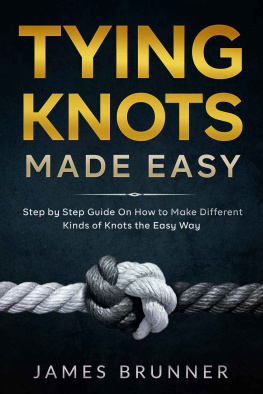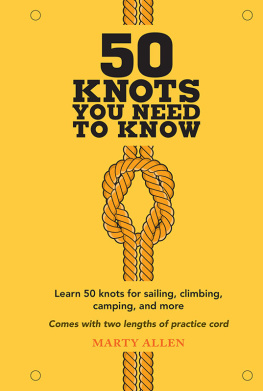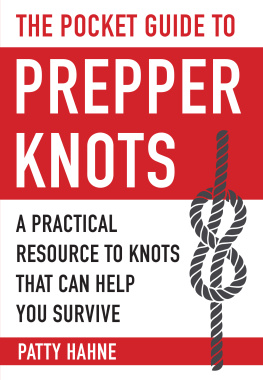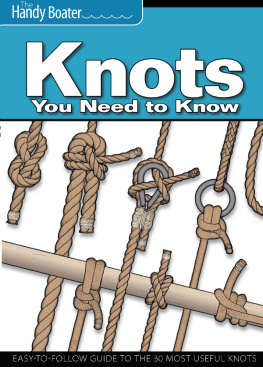You will never need to buy another book on knots.
Pittsburgh Tribune-Review
An excellent resource for beginning and intermediate backcountry adventurers.
Outside Bozeman
Outdoorsy folk have been known to be obsessive about certain things, and this book could no doubt serve as a quintessential reference book.
Reno Gazette-Journal
The Outdoor Knots Book is a great resource for any outdoor types in your family. This concise and well-illustrated book details how to make more than 40 of the most common (and not so common) rope knots that are used by campers, hikers, paddlers and climbers.
Camping Life magazine
This book is not to be missed if youre an outdoors person.... The scope of the book makes it a must-read for outdoors enthusiasts.... The how-to-tie instructions and photographs will soon have you making a double bowline with out a hitch.
Los Angeles Daily News
A thorough guide.
Sacramento Bee
Whether cinching down a load on a horse or a pickup, securing a tent or a canopy, this book has some tried-and-true traditional and relatively new knots.
Salem Statesman Journal
The preferred alternative for someone who wants a handy, practical reference.
Great Falls Tribune

The Outdoor
Knots Book
Hikers | Campers
Climbers | Kayakers
Clyde Soles


THE MOUNTAINEERS BOOKS
is the nonprofit publishing arm of The Mountaineers Club,
an organization founded in 1906 and dedicated to the exploration,
preservation, and enjoyment of outdoor and wilderness areas.
1001 SW Klickitat Way, Suite 201, Seattle, WA 98134
Text and photographs 2004 by Clyde Soles
All rights reserved
First printing 2004, second printing 2005, third printing 2007, fourth printing 2008, fifth printing 2009, sixth printing 2011
No part of this book may be reproduced in any form, or by any electronic, mechanical, or other means, without permission in writing from the publisher.
Distributed in the United Kingdom by Cordee, www.cordee.co.uk
Manufactured in the United States of America
Acquiring Editor: Cassandra Conyers
Project Editor: Kate Rogers
Copy Editor: Joan Gregory
Cover Design: Karen Schober
Interior Design: The Mountaineers Books
Layout Artist: Ani Rucki
Cover photograph: Jim Martin
Library of Congress Cataloging-in-Publication Data
Soles, Clyde, 1959
The outdoor knots book / Clyde Soles. 1st ed.
p. cm.
Includes bibliographical references and index.
ISBN 0-89886-962-5 (pbk.)
1. Climbing knots. 2. Outdoor life. I. Title.
GV200.19.K56S65 2004
796.52'2dc22
2003025508
 Printed on recycled paper
Printed on recycled paper
ISBN(paperback): 978-0-89886-962-0
ISBN(ebook): 978-1-59485-216-9
Contents
Foreword
Like many of you, I managed to get along in the outdoors for years knowing only a handful of knots. I adhered to the common wisdom that there was no need for all them fancy knots and muddled through with my basic setsometimes with surprising, and unpleasant, results.
Eventually, I started picking up knot and rope-handling tricks that greatly simplified life when I was playing in the mountains and on rivers. Adding to my repertoire enhanced both my speed and safety. There is much to be said for quickly tying the appropriate knot instead of dinking around trying to make something work.
Numerous books have been written about knots. Most overwhelm readers with fifty ways of joining two ropes or a hundred variations of a loop, with hardly any discussion of why one knot might be better than another. The preponderance of nautical knots that have few if any applications for nonsailors (or even real sailors) dilutes the usefulness of many knot books. And surprisingly, very few give much information about the ropes themselves.
In The Outdoor Knots Book, I have narrowed the list of knots down to those most practical for hikers, campers, climbers, scramblers, canoeists, kayakers, and pretty much anyone else who spends time playing outside. Some you probably already know, though I might teach you new tying methods or helpful variations. Others may be knots you were aware of but too intimidated to try, or perhaps you were unclear about their applications and advantages. Yet others may be completely new additions to your bag of tricks.
Perhaps Ive left out your favorite knotthere are certainly many other worthy candidates. Use these described here to build your knowledge base, then supplement with additional knots as the need arises.
Since knots depend on ropes and webbing, Ive devoted the first couple chapters to describing the various materials and processes used in making cordage. Armed with this knowledge, you can select the best rope or webbing for the job. Equally important is learning how to care for cordage and tricks for handling ropes to avoid snafus.
After you have read the information on selecting and caring for cordage, the best way to use The Outdoor Knots Book is to sit down with rope in hand. A forgotten knot does you no good. Read the words, study the pictures, and practice each knot. When you can tie it with your eyes closed, you will have really learned a knot.
Warning: Different ropes, or combinations of ropes, can yield very different results when knotted. When reliability is critical to safety, be certain to test the specific ropes and knots beforehand.
Acknowledgments
Over the years, many people have contributed to my knowledge of ropes and knots. When I was the Gear Editor at Rock & Ice magazine, I wrote several reviews of climbing ropes, visited five rope manufacturers in the United States and Europe to watch production, talked with designers, and performed tests. This experience gave me a greater appreciation for ropes as well as a better understanding of their limitations.
A major contributor to this work has been Dan Lehman, a knot aficionado, who provided excellent commentary. Thanks to Michelle Harris who kindly demonstrated coiling techniques. Others who have helped out, knowingly or not, include Chris Harmston, Karl Lew, Loui McCurley, and Regan Velasquez. Also, thanks again to my dad, who started me in the outdoors when I was six.

Chapter
1
Rope Materials &
Construction
Ropes seem mundane at first. But they are pretty cool when you take a closer look. A rope is one of mankinds oldest tools and a good example of synergy: The whole is greater than the sum of its parts. Without rope, neither Stonehenge nor the Great Pyramids nor many other ancient wonders would have been possible.
Ropes did not change much for, oh, say 50,000 years. Probably much longer. Once we progressed beyond vines, it was always a matter of twisting some natural fibersplant stalks, tree bark, hair, sinew, whateverinto cohesive units. Refinements were made, but the basics were worked out long ago.
Then came synthetics. And improved manufacturing processes. In the 1940s, the new materials replaced natural fibers in countless applications and revolutionized the world. In the 1970s, rope-making technology took another leap forward with new construction technologies and combinations of materials. Then in the 1980s, hyper-strong fibers emerged and ropes previously considered impossible became available. It is possible that another revolution in rope technology is around the corner.
Next page











 Printed on recycled paper
Printed on recycled paper